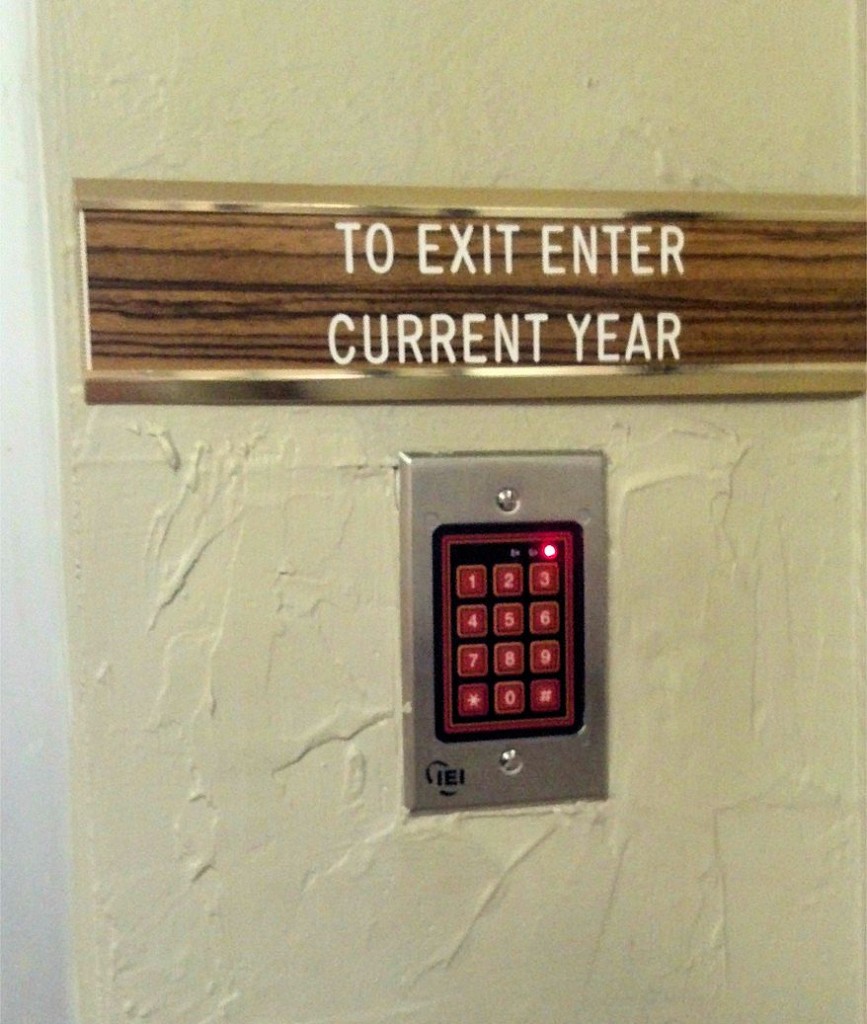Thank you to everyone who told me the website was down this a.m.! It was a problem at the server so the host was working on it. It’s times like this when it becomes evident how many people rely on the site, and that warms my heart! 🙂
Today’s Fixed-it Friday photo was found on Imgur, so I don’t know where it originated. It shows the creative use of an access control keypad to control egress. If this application was used in a memory care facility, it would be code-compliant if a delayed egress system or controlled egress system was used (assuming the other requirements were met). If you’re not clear what the IBC and NFPA 101 require for those two systems, I’ll be posting my Doors & Hardware article on the topic next week.
You need to login or register to bookmark/favorite this content.







It is not code compliant anywhere in the US since operation requires reading the sign – difficult for the blind.
That’s an interesting point…if the keypad is not required by code, does the sign have to meet accessibility requirements? In the two applications I mentioned, the keypad is just a convenience.
Does that particular IEI have a calendar and clock?
I don’t know but I’m guessing they just change the code once a year.
It may not be in order to unlock. It might just be required to turn off the alarm. I’ve seen that at an elderly dementia care location. The door to the stair is alarmed and allows free egress but the alarm goes off. The keypad is just to pre-de-activate the alarm, not unlock the door.
True. The keypad could shunt an alarm, it could disarm a delayed egress lock, or it could unlock a controlled egress lock – all would be acceptable egress-wise per the IBC or NFPA 101 (2009 editions or later for controlled egress). Dawn raised an interesting question in her comment though…the signage is not code-compliant for accessibility, but if the keypad is not required, does it need to be accessible? I’m hoping someone comes up with the answer because I don’t know for sure.
– Lori
Short version: The IBC only requires the minimum life safety signage to be accessible, but ADA says if you sign it it had better be accessible.
The IBC is very specific regarding where accessible signage is required. Examples include Accessible parking spaces, toilet rooms, areas of refuge, and directional signage for accessible routes. This is all in section 1110 (2012 version).
The 2009 ANSI A117.1 says “Communications elements and features required to be accessible by the scoping provisions adopted by the administrative authority shall comply with the applicable provisions of Chapter 7.” In other words, if it isn’t required. It doesn’t need to be accessible. This matches IBC chapter 10 on accessible means of egress where it regulates “raised character and braille exit signs” which are again very specifically required for things like areas of refuge and stairway identification.
BUT WAIT, THERE’S MORE!
ADA has it’s own set of scoping provisions. Specifically in the 2010 standards, section 216.3 states “Signs that provide direction to or information about interior spaces and facilities of the site shall comply with 703.5.” This is then followed with an advisory that states “Information about interior spaces and facilities includes rules of conduct, occupant load, and similar signs. Signs providing direction to rooms or spaces include those that identify egress routes.”
That is a pretty broad set of statements that could be easily interpreted to include ANY signage within a facility, including instructions on how to get out.
I have seen this at many elderly care facilities especially at Alzheimer care wards . This is strictly for the visitors and all other code compliant issues are met . Fire code and emergency egress are met with exit delay devices or mag locks tied into pull stations . Unfortunately in this picture you cannot see the door itself .
This is how the exit at my mom’s nursing facility works. On the way out of one door it cautions visitors not familiar with residents not to let them out (I’ve accidentally done that to one very convincing patient but fortunately the nurse saw). It’s troublesome to me that it is easy to get in but not to get out. There is a simple button that allows entrance to the facility – one even has a sign advising how it works. On the way out, a sticker resides on top the key pad that tells you to enter the month/year to exit but it is no longer accurate because they changed all the codes to be the same.
It’s so hard to find the balance between convenience, security, and life safety. I hope your mom’s facility doesn’t experience any problems given the lack of security.
– Lori